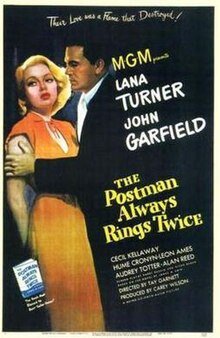Introduction
On May 2nd, 1946, a cinematic masterpiece was released that would go on to captivate audiences with its gripping tale of love, betrayal, and murder. “The Postman Always Rings Twice,” directed by Tay Garnett and featuring stars Lana Turner and John Garfield, is a film adaptation of James M. Cain’s novel. This noir classic remains a significant milestone in the history of cinema, leaving a lasting impact on audiences and inspiring countless future filmmakers.
The Plot and Characters
In “The Postman Always Rings Twice,” the story revolves around Frank Chambers, a drifter who finds himself entangled in a passionate affair with Cora Smith, the wife of a middle-aged Greek restaurant owner, Nick Papadakis. The illicit lovers hatch a plan to murder Nick and claim his life insurance money, setting in motion a series of events that lead to their ultimate downfall.
Lana Turner delivers a remarkable performance as the seductive and manipulative Cora Smith, while John Garfield portrays the rugged and morally ambiguous Frank Chambers. Their on-screen chemistry and the intensity of their performances bring the characters to life, making them both relatable and intriguing to the audience.
The Film’s Impact
“The Postman Always Rings Twice” is renowned for its visual and dramatic intensity, which was a departure from the traditional Hollywood storytelling of the time. The film’s noir elements, including its morally ambiguous characters, dark themes, and atmospheric cinematography, set it apart from other movies of the era.
The release of “The Postman Always Rings Twice” marked a turning point in Hollywood’s approach to storytelling and filmmaking. It paved the way for future noir classics and inspired a new generation of filmmakers to explore darker and more complex narratives.
Reception and Legacy
Upon its release, “The Postman Always Rings Twice” received critical acclaim for its gripping storyline, exceptional performances, and innovative cinematography. Audiences were drawn to the film’s morally ambiguous characters and its exploration of love, desire, and betrayal.
The film’s success led to several adaptations and remakes over the years, including a 1981 version starring Jack Nicholson and Jessica Lange. However, the 1946 adaptation remains a timeless classic that continues to be celebrated for its contribution to the film noir genre.
References and Further Reading
If you’re interested in learning more about the historical significance of “The Postman Always Rings Twice” and its impact on cinema, here are some recommended references:
- James M. Cain’s novel “The Postman Always Rings Twice” – https://www.goodreads.com/book/show/33583.The_Postman_Always_Rings_Twice
- “The Postman Always Rings Twice” (1946) on IMDb – https://www.imdb.com/title/tt0038854/
- “The Postman Always Rings Twice” (1981) on IMDb – https://www.imdb.com/title/tt0082934/
- “The Postman Always Rings Twice” – A Critical Overview – https://www.criterion.com/current/posts/229-the-postman-always-rings-twice-a-critical-overview
These resources will provide you with a comprehensive understanding of the film’s historical context, its impact on cinema, and its enduring legacy.
Conclusion
“The Postman Always Rings Twice” remains a timeless classic that continues to captivate audiences with its gripping storyline, exceptional performances, and innovative cinematography. Released on May 2nd, 1946, this noir masterpiece has left an indelible mark on the history of cinema, inspiring countless filmmakers and setting a new standard for storytelling in Hollywood.
Whether you’re a fan of film noir or simply appreciate the power of a well-crafted narrative, “The Postman Always Rings Twice” is a must-watch. Its exploration of love, betrayal, and the consequences of one’s actions will leave you enthralled from beginning to end.

